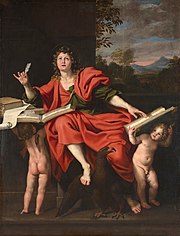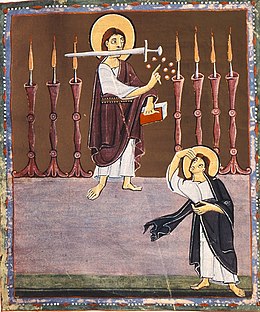| Part of a series of articles on |
| John in the Bible |
|---|
 Saint John the Evangelist, Domenichino Saint John the Evangelist, Domenichino |
| Johannine literature |
| Authorship |
| Related literature |
| See also |


John's vision of the Son of Man, also known as John’s Vision of Christ, is a vision described in the Book of Revelation (Revelation 1:9–20) in which the author, identified as John, sees a person he describes as one "like the Son of Man" (verse 13). The Son of Man is portrayed in this vision as having a robe with a golden sash, the hair on his head was white like wool, as white as snow, and his eyes were like blazing fire. His feet were like bronze glowing in a furnace, and his voice was like the sound of rushing waters. He holds seven stars in his right hand and has a double-edged sword coming out of his mouth. The vision is interpreted by Christians as the only identifiable physical description of Jesus in any form in the Christian biblical canon.
Account
John of Patmos, the author of the Book of Revelation, wrote how on the Lord's Day he was "in the Spirit", and heard a loud voice "like a trumpet" (Revelation 1:10). When he turned around, he saw this Son of Man figure. In Revelation 1:18, the figure identifies himself as "the First and the Last", who "was dead, and behold I am alive for ever and ever", a reference to the resurrection of Jesus.
Connection with the rest of the book
Some of the language used in Revelation 1 is also used in Revelation 19 to describe the Rider on the White Horse. In both places, he has a sword coming out of his mouth (1:16 and 19:15) and has "eyes like blazing fire" (1:14 and 19:12). The sword proceeding from Jesus’ mouth describes the counterintuitive way God's messiah conquers: by the word of God.
The Son of Man is portrayed as walking (2:1) among seven lampstands, which represent the seven churches of Asia (1:20). In Revelation 1:11, he says, "Write on a scroll what you see and send it to the seven churches". Chapters 2 and 3 report the content of the letters written to the angels of the seven churches. Throughout the letters he is identified in terms of the vision, such as "him who has the sharp, double-edged sword" (Revelation 2:12).
Connection with the Book of Daniel
| This section possibly contains original research. Please improve it by verifying the claims made and adding inline citations. Statements consisting only of original research should be removed. (November 2020) (Learn how and when to remove this message) |
| Revelation 1 | Daniel 10 |
|---|---|
| 1:13 one like a son of man, wearing an ankle-length robe, with a gold sash around his chest | 10:5 a man dressed in linen with a belt of fine gold around his waist |
| 1:14 his eyes were like a fiery flame | 10:6 his eyes were like fiery torches |
| 1:15 His feet were like polished brass refined in a furnace | 10:6 his arms and feet looked like burnished bronze |
| 1:15 his voice was like the sound of rushing water | 10:6 the sound of his voice was like the roar of a multitude |
| 1:16 his face shone like the sun at its brightest | 10:6 his face shone like lightning |
There is a striking resemblance between John's and Daniel's visions of a son of man. In John's vision the Son of Man has white hair, a sword, and lampstands. In Daniel's vision the Son of Man has a body resembling tarshish, which Rabbi Rashi explains – quoting Tractate Hullin 9lb – as the man being as large as the Tarshish Sea in Africa. Rashi interprets Daniel's Son of Man to be the archangel Gabriel.
In Jewish mysticism, the angels are the heavenly priests of God who serve in his heavenly temple in his heavenly Jerusalem; hence Gabriel wearing priestly robe and sash. Jesus is similarly depicted because, according to the New Testament, he is the eternal high priest of mankind.
Explanation and interpretation
| This section possibly contains original research. Please improve it by verifying the claims made and adding inline citations. Statements consisting only of original research should be removed. (November 2020) (Learn how and when to remove this message) |
| Element | Biblical reference | Suggested meaning |
|---|---|---|
| Seven gold lampstands | Zechariah 4:11, 14 "What are...the lampstand?...These are...the Lord of all the earth." | The menorah used in the tabernacle and in the temple |
| Robe and golden sash | Exodus 28:4 "These are the vestments they shall make:...a robe,...and a sash. In making these sacred vestments which your brother Aaron and his sons are to wear in serving as my priests." | "Reminders of the official dress of the High Priest" |
| White hair | Isaiah 1:18 "Though your sins are like scarlet, they will be as white as snow; though they are as red as crimson, they will become like wool." | Like that of the Ancient of Days in Daniel 7 "Wisdom and the dignity of age" |
| Eyes like blazing fire | Psalm 139:12 "Even the darkness is not dark to You, but the night shines like the day, for darkness is as light to You." | They "read every heart and penetrate every hidden corner" |
| Feet like bronze | Ezekiel 1:27 "...and from what looked like the waist down, I saw something like the appearance of fire and brilliant light surrounding him." | Strength and stability Trampling enemies |
| Voice like rushing waters | Ezekiel 1:24 "Then I heard the sound of their wings, like the roaring of mighty waters, like the voice of the Almighty." | "The awe-inspiring power of a great waterfall" |
| Holding seven stars in his right hand | Deuteronomy 1:10 "The LORD your God has multiplied you, so that today you are as numerous as the stars in the sky." | Pleiades in Job 38:31 Supreme political authority "The right hand can be interpreted as a source of power and protection" Astrological imagery: "The stars may be thought of as controlling human fate, but Jesus controls the stars" |
| Double-edged sword coming out of his mouth | Ephesians 6:17 "And take...the sword of the Spirit, which is the word of God." | "His Word that works to save and to destroy" |
| Face like the sun | Isaiah 60:19 "No longer shall the sun be your light by day,...Rather, the LORD will be your light forever." | As at the Transfiguration |
William Hendriksen suggests that the whole of the vision "is symbolical of Christ, the Holy One, coming to purge His churches," and to "punish those who are persecuting His elect."
Significance of the seven stars
John tells us in Revelation 1:20 that the seven stars are the angels of the seven churches (Revelation 1:20)
In the New Testament, the Greek word for angels (aggelos) is not only used for heavenly angels, but also used for human messengers, such as John the Baptist (Matthew 11:10, Mark 1:2, Luke 7:27). Merrill Unger is of the opinion that human messengers is the meaning of the stars. In commenting on this verse, C. I. Scofield states: "The natural explanation of the "messengers" is that they were men sent by the seven churches to ascertain the state of the aged apostle ... but they figure any who bear God's messages to a church."
Several New Testament scholars believe that the angels are not human messengers. Isbon Beckwith says they represent the churches "ideal conception of its immanent spirit". Henry Barclay Swete refers to the angels as the "prevailing spirit" of the church.

One aspect of the vision is the portrayal of Jesus holding seven stars in his right hand. Such a motif is also found on coins of the Emperor Domitian. Sometime between 77 and 81, Domitian's infant son died. He was subsequently deified, and is portrayed on coins of Domitian, with seven stars. Ernest Janzen argues that the globe on which the infant stands represents world dominion and power, while the stars indicate his divine nature; he is depicted as "the son of (a) god" and "conqueror of the world." Although Domitian's son cannot be said to be holding the stars, some scholars have drawn parallels between the numismatic and biblical evidences. Frederick Murphy notes that "Revelation's image of Jesus with seven stars in his hand may be an allusion to that coin and an implicit critique of it. It is not the Roman imperial family that has cosmic significance, but Jesus."
Austin Farrer, on the other hand, takes them to be the seven classical planets, and interprets the vision as representing Christ's lordship over time.
See also
- Chronology of Revelation
- Resurrection appearances of Jesus
- Son of man (Christianity)
- Son of man (Judaism)
References
- David L. Barr, “Apocalypse as Symbolic Transformation for the World,” Interpretation, 38 (1953), 39–50
- Chabad Tanakh: Rashi's Commentary on Daniel 10:6
- Chabad Tanakh: Rashi's Commentary on Daniel 11:1
- "ANGELOLOGY – JewishEncyclopedia.com". www.jewishencyclopedia.com. Retrieved 2023-10-25.
- "Hebrews, CHAPTER 5 | USCCB". bible.usccb.org. Chapter 5:1–10. Retrieved 2023-10-25.
- ^ David Chilton, The Days of Vengeance: An Exposition of the Book of Revelation (Dominion Press, 1987), pp. 73–76.
- ^ Leon Morris, The Revelation of St. John (Tyndale, 1969), p. 53.
- ^ William Hendriksen, More Than Conquerors: An Interpretation of the Book of Revelation (Tyndale Press, 1962), p. 56.
- ^ Robert H. Mounce, The Book of Revelation (Eerdmans, 1977), p. 79.
- ^ John Gill, Exposition of the Entire Bible Archived 2013-02-08 at the Wayback Machine
- Simon J. Kistemaker, Exposition of the Book of Revelation (Baker, 2002), p. 97.
- ^ Murphy, Frederick J. (1998-08-01). Fallen Is Babylon: The Revelation to John. Bloomsbury Academic. p. 91. ISBN 978-1-56338-152-2.
- Unger, M., Unger's Bible Dictionary, (Chicago, Illinois: Moody Press, 1975) p. 52
- Scofield, W. I., The Scofield Study Bible (New York: Oxford University Press, 1996) p. 1331.
- Isbon T. Beckwith, The Apocalypse of John (NY: MacMillan Company, 1919; reprinted Wipf and Stock), p. 446, emphasis Beckwith’s.
- Henry Barclay Swete, Commentary on Revelation: The Greek Text (1906, reprint Grand Rapids, Michigan: Kregel Publications, 1977), p. 22.
- Brian W. Jones, The Emperor Domitian (Routledge, 1993), p. 36.
- Ernest P. Janzen, "The Jesus of the Apocalypse Wears the Emperor's Clothes," SBL Seminar Papers 130 (1994): 645–647.
- Austin Farrer, "Inspiration, Poetical and Divine," in Interpretation and Belief, p. 47.